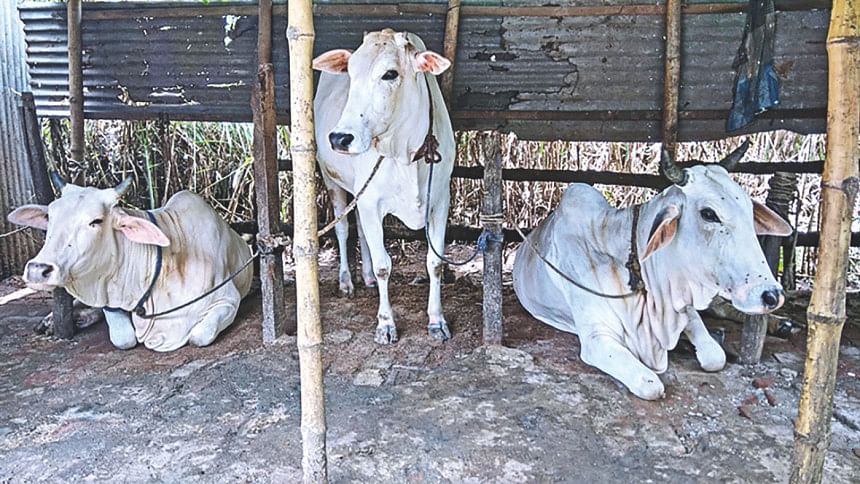A cut above: The Mirkadim breed of cows

But dig deeper, and you will realise Mirkadim is like no other. It is the home of Mirkadim cows, a distinct class in our livestock industry — the highly celebrated and premium, 'Mirkadim er goru'. The cattle have set this area apart from the rest, with its name forever twinned with that of the cows it farms.
What really makes Mirkadim's cows so exclusive?
Anwar Hossain, a cattle farmer who has been raising such cows for more than 15 years, says that first and foremost, the appearance itself is a key reason for the fame.
"There is a demand for white cows. People find them pleasing to look at," Hossain opined.
But not all white cows are created equal.
"The Mirkadim cows usually have subtle pinkish hues in some parts of the body, giving them a rather distinctive look," he added.
Moreover, the meat of these cows is superior in taste. It is of premium quality — our answer to Kobe beef!
What owes to the superior taste, though?
"The feeds of Mirkadim cows are more diverse and richer," informed Hossain, who, this year, has four of these cattle to sell in the market.
He bought them about eight months ago in exchange of Tk 3,20,000. Add to that the hefty cash outflow he bears to buy expensive fodder. However, he is confident that it's all worth it — Mirkadim cows sell at relatively higher prices too, and Hossain hopes for a decent mark-up.
The same confidence is shared by Anis as well, another cattle farmer who lives nearby.
"I usually do not need to go to the cattle market at all. Customers send their people to have a look and they directly buy from my cowshed," he says.
His secret to success is also shared with Hossain and other such farmers. "Go to any ordinary farm and see the quantity, richness, and the types of fodder. Compare that with ours and the difference will become apparent."
The fodder makes a lot of difference, and so does the level of care taken.
"If a drop of rain touches my cow, I take out my own gamcha and wipe it out," Hossain explains how meticulous they are with their cattle.
A peek at the cowshed of Idris Haque, another Mirkadim farmer, would suffice to get an idea of the dedication. You will be surprised how neat and clean the cowshed is. You will be impressed that there are fans attached for the comfort of the animals. And you will understand that some thought went into building the cowshed itself: modest, but relatively spacious and a more robust structure in comparison to those of typical farmers.
"It is not uncommon that Mirkadim cows can sell rather quickly once taken to the 'haat'. You do not need to wait for days and days," Haque says. "That's the fruits of our labour."
And laborious and expensive the farming is!
With the hard work and costs that come with this business, many like Haque are concerned about the future.
"When I was a child, there were more families involved in farming Mirkadim cows than there are now. Many have shifted to cross-breed cattle," he said.
This thought gets reinforced when he goes to Rahmatganj Haat every year, a cattle market which has long been branded as the ultimate marketplace of Mirkadim cows. "With changing times, the haat nowadays bring up more variety; the exclusivity is waning away."
The Mirkadim cow is like no other. From the special care taken to the rich feeds they are fed, the cows are premium, their meat distinctively tastier, even a heritage — a cut above.
This begs the question — after one visits the cowsheds in the area and on his way back to Dhaka — can Mirkadim, amidst the whirlwind of changes and the hard realities of trade and life at large, retain the glory of its special cattle that have made it so famous?

 For all latest news, follow The Daily Star's Google News channel.
For all latest news, follow The Daily Star's Google News channel. 



Comments